Order yours from £65 from sarahk.co.uk
Weed of the Month – Common Cats-ear
24.07.2023 - 12:30 / hgic.clemson.edu
Common cats-ear (Hypochaeris radicata) is a perennial weed. Its name comes from the dense hairs that cover the leaves. It looks very similar to dandelions, but its leaves are not as deeply notched. It also produces yellow flowers and puffball seed-heads very similar to dandelions. Common cats-ear flowers throughout the summer and most heavily in September. Common cats-ear is native to Europe and Northern Asia and can become quite a problem in thin, open areas. The first step in maintaining a thick, healthy lawn is ensuring that you have selected the best grass for your landscape. For more information on the characteristics of different turfgrasses, please see HGIC 1223, Turfgrasses for the Carolinas.
Common cats-ear produces an average of 2,300 seeds per plant but can produce as many as 6000 seeds per rosette. Luckily the seeds do not persist long in the soil, because their viability is limited to less than a year. Moist soil conditions and light are required for germination. The seeds germinate mostly in the fall and less in the spring. For the first year the plant will remain in a basal rosette. A flower will develop the second year; the plant can persist for several years.
Mowing does not control this weed and, even worse, it stimulates flower production. Regular mowing can double the number of flower stalks produced, especially if the lawn is routinely scalped. To make sure that you are mowing your lawn at the correct height see HGIC 1205, Mowing Lawns.
Hand pulling and digging can be very effective. Common cats-ear has a deep taproot but do not worry, removing the crown of the plant provides control, because common cats-ear is unable to resprout from root fragments. Postemergent herbicides applied in the fall are
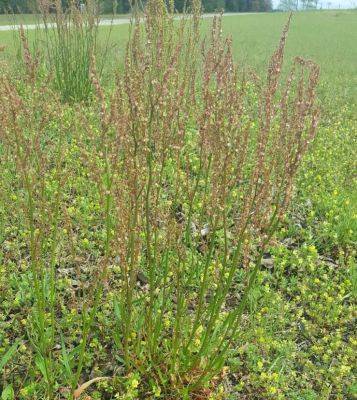
Weed of the Month – Red Sorrel
Red sorrel (Rumex acetosella) is a perennial weed that is easily identified by its red flowers and spade-shaped leaves. It is a member of the buckwheat family and native to Europe. The plant produces large quantities of pollen that can contribute to hay fever. The weed is edible, and some people grow it as a green or an herb. The tart flavor is often compared to lemons or sour apples. While the plant is safe for humans, it is toxic to livestock.
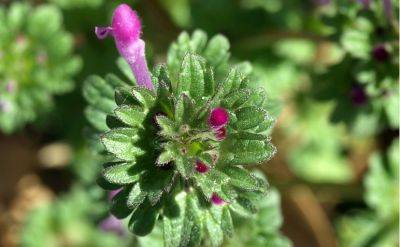
Weed of the Month – Henbit
Henbit (Lamium amplexicaule) is a winter annual, broadleaf weed. It germinates in the fall and actively starts to grow in the cool spring weather when adequate soil moisture is present. Henbit is related to ornamental Lamium and is a member of the mint family. Its purple flowers serve as an early source of nectar and pollen for honeybees and bumblebees.
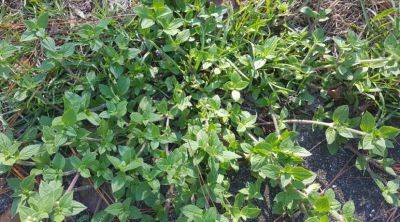
Weed of the Month – Florida Pusley
Florida pusley is a low-branching, annual summer weed. Its pretty, white, star-shaped flowers produce an abundance of seeds, and a single plant can quickly turn into an infestation. This weed is extremely drought tolerant and can easily out compete lawns that are not irrigated during extended dry weather conditions.
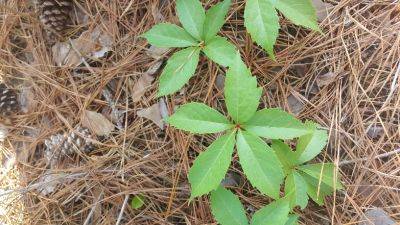
Weed of The Month – Virginia Creeper
Virginia creeper is a native North American, deciduous vine, which can easily climb 30 feet or higher. Its tendrils end in oval shaped disks that adhere to surfaces and can damage stucco, the mortar between bricks, and painted surfaces. This highly adaptable plant grows in full sun to full shade. Grown as a groundcover, it can provide erosion control on slopes. Virginia creeper is very drought tolerant and a vigorous grower. To control the spread of this somewhat aggressive vine, prune, mow, or weed whack in the spring.
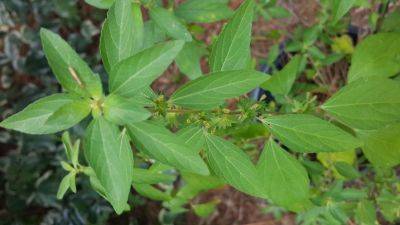
Weed of the Month – Virginia Copperleaf
Virginia copperleaf is a tall, branched summer annual that can grow three feet tall. It takes its name from the copper colored leaves of its late summer color. This weed is a North American native that is found from Maine to Georgia and as far west as Texas and north to South Dakota. It is a member of the spurge family and is poisonous, but it does not have the milky sap that is typical of other family members. The simple leaves are oppositely arranged on the stems when the plant is a young seedling, but they change to an alternate arrangement as the weed matures.
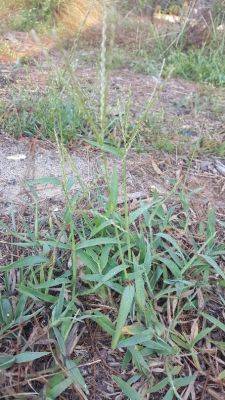
Weed of the Month: Crabgrass
It’s late summer and crabgrass weeds have invaded some lawns. Unfortunately, crabgrass is very difficult to control with most herbicides once it develops a few tillers or branches. There are several species of crabgrass (Digitaria spp.): tropical crabgrass, smooth crabgrass, India crabgrass, large crabgrass, Southern crabgrass, and blanket crabgrass. All of them are summer annuals that germinate primarily in spring, grow during the summer, set seeds, and then die with the first frost.
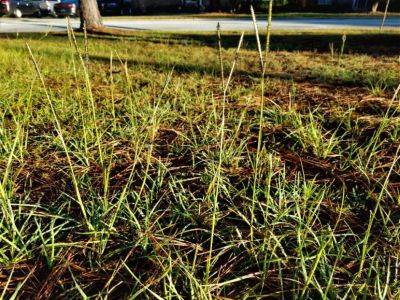
Weed of the Month: Bahiagrass
Bahiagrass (Paspalum notatum) is commonly referred to as highway grass. It’s a tough, drought tolerant, perennial grass that survives in soils with low fertility. Due to its very coarse and open growth habit, bahiagrass is considered a low-quality lawn grass. It is best suited to use as a utility grass for roadsides and erosion control in marginal areas where visual quality is not a high priority.
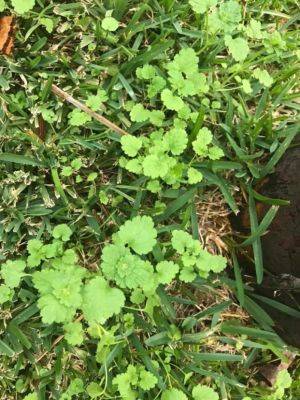
The Key to Winter Weed Control is to Start Early
It never fails that come March and April, the desire for many of our lawns to begin to breaking dormancy is met with the horror that the only things that seem to be green are the weeds that we have been ignoring throughout winter. This may include white clover, dandelions, chickweed, the painful lawn burweed, or so any other species. These weeds may be welcome to some homeowners as some serve as early pollen sources for pollinators, but they can also be a nuisance to others.
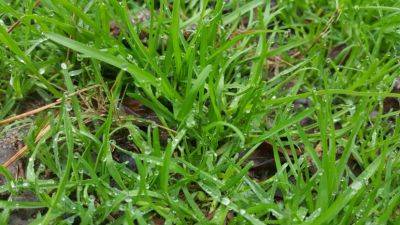
Weed of the Month – Annual Bluegrass
That bright green, grassy weed in your lawn this month could be annual bluegrass. It is a cool-season, annual weed that grows in moist and compacted soils and even in shady locations. It is a prolific seed producer even when mowed at low heights, with each plant producing over 350 seeds. The first step to getting this weed under control in home lawns is to irrigate the lawn properly. Always apply deep but infrequent irrigation to lawns during periods of inadequate rainfall. This will encourage the turfgrass to have a deeper, more robust root system and help it compete with the annual bluegrass for moisture. Wait until the lawn begins to show symptoms of drought stress before irrigating, especially in the early fall. Annual bluegrass seeds germinate in autumn when soil temperatures drop below 70 °F. Limiting soil moisture near the soil surface reduces the germination rate of annual bluegrass seeds in the lawn.
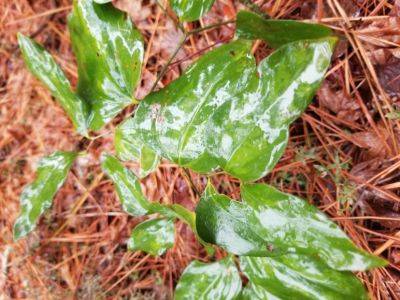
Weed of the Month: Smilax (Greenbrier)
Smilax vines go by the common names greenbrier or catbrier due to the thorns covering their stems. There are 300 to 350 smilax species worldwide. Approximately twenty-four species are native to North America, with fifteen species growing in South Carolina. Smilax grows well in moist shade and is an important food source and habitat for wildlife, including birds, rabbits, and deer.
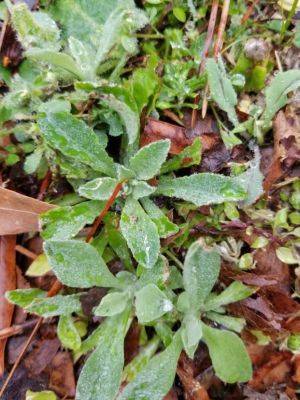
Weed of the Month – Cudweed
Cudweeds (Gamochaeta spp.) are herbs in the aster family that serve as host plants for American painted lady caterpillars. There are about fifty plus species, and all are native to the Americas. Most cudweeds are annuals and can be either winter or summer annuals. They flower in mid-spring to early summer or in early fall. Some cudweeds can be biennial, meaning that they will form a basal rosette that can survive the winter and flower in their second year.
